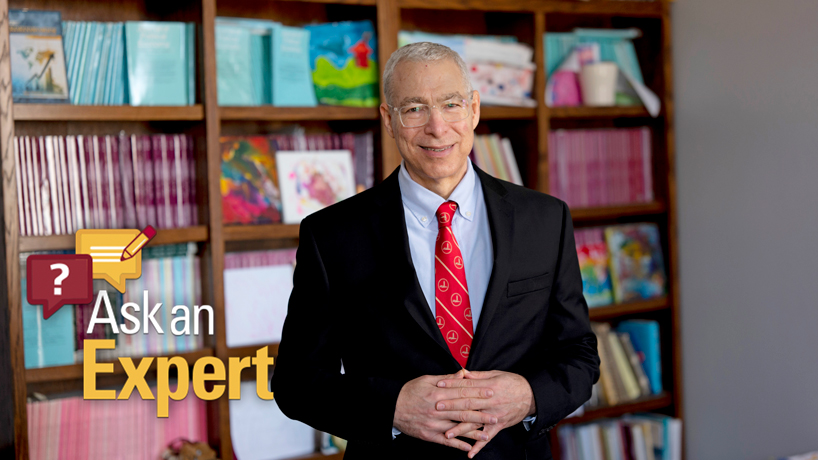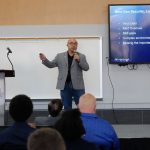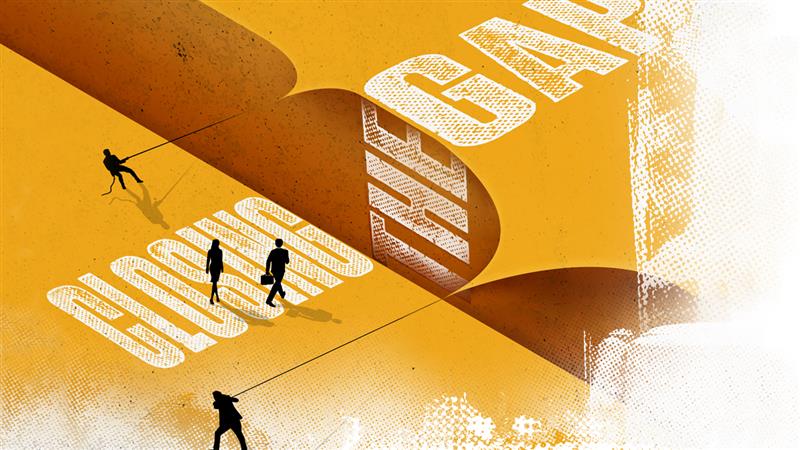
Max Gillman, the Friedrich A. Hayek Professor of Economic History at the University of Missouri–St. Louis, recently authored a book titled “The Spectre of Price Inflation,” published by Columbia University Press. (Photo by August Jennewein)
Inflation dominated news coverage throughout 2022, and even people who might have been programmed to change the channel or avoid the headlines couldn’t miss its impact when they went to their local grocery store or favorite restaurant.
Things – everyday things – have just been costing more.
Though inflation has ticked back down over the past few months, falling to 5% in March for the first time since May 2021, it remains higher than Americans have been accustomed to since the early 1980s. Its impact continues to be felt throughout the economy, including with last month’s collapse of Silicon Valley Bank, which marked the second-largest bank failure in United States history and the largest since the 2007–2008 financial crisis.
Max Gillman, the Friedrich A. Hayek Professor of Economic History at the University of Missouri–St. Louis, recently authored a book titled “The Spectre of Price Inflation,” published by Columbia University Press. It provides an overview of the role of inflation in the modern economy, from its place in monetary policy and bank insurance “macroprudential” policy to the impact it has on everyday business decisions.
In the latest installment of the Ask an Expert series, UMSL Daily talked to Gillman about what’s been happening with inflation over the past two years, some of which he predicted in his book.
How long have you been studying inflation?
From my PhD onwards. I have published on inflation from 1993 through 2023 now, almost every year. I combine mathematical models with empirical applications in most of my inflation publications, including in some top-tier journals. That’s always been my No. 1 focus. I do business cycle and growth theory often combined with monetary theory and also study public finance in terms of the effects of fiscal tax rates and tax evasion. Tax evasion is a related application of studying the distortions to the economy from people avoiding or evading the “inflation tax,” by decreasing their real money demand. The inflation tax is a regressive tax caused by the central bank financing government spending by printing money to buy government debt that then affects business cycles and decreases economic growth. Lowering all tax rates including the inflation tax can induce the same amount of tax revenue with less distortions from less tax evasion/avoidance. I emphasized this in talks I had in Russia with officials during Putin’s first month as acting president in December 1999 and with President Erdogan in Istanbul last September.
For almost all of that time, inflation has stayed pretty low to the point where most people never really thought about it. When you were first approached about doing the book, did you have any idea it was going to be this much in the minds of everyday people?
No. In fact, in my first draft of my introduction, I said, “It’s sort of hard to write a book about inflation when nobody thinks it matters, but here’s the book …” But I did about four drafts. By the time of my last draft in May, I said, “Well, inflation’s going up. I didn’t expect that when I took on the project, but now it’s happening.” Then my editor said to just cut that out, so it’s not even in there at all. It just goes into the book. But I did not expect it.
Was what happened over the past two years something you anticipated? Or has it been surprising to see inflation spike the way it has?
I basically anticipated it in the book. By the time I was writing these last versions in May 2021, inflation had risen maybe to 5%, and everywhere, they were all saying in the Biden administration, that it’s just going to be a blip. I said in the book that, rather than a blip, this is most likely going to be a prolonged episode – like in the 1970s and ’80s. So that has been true. What I wrote in the book, in that sense, is true.
But in addition, the book is focused on how the government conducts insurance over the private banking sector. So the other part of my “predictions” in the book are that this is creating increasing financial risks.
What happened with Silicon Valley Bank seems like one example of that. How did high inflation contribute to SVB’s failure?
The crisis that we had in banking was because these people bought long-term bonds, and the reason they did that is because the usual safe asset – short-term treasury bills – were yielding negative real rates of return. The interest rate was lower than the inflation rate for 20 out of the last 23 years, so all the portfolio managers had to find a riskier but close-to-safe asset. So one’s been long-term government bonds. The other is mortgage-backed securities. That’s what they bought, and then when they raised interest rates rapidly in 2005 and 2006, that caused the crash in 2008 – the mortgage-backed securities. This time, it’s long-term government debt that caused the SVB collapse when the Fed suddenly raised the interest rates.
The Fed artificially kept interest rates below the inflation rate for 20 out of these 23 years. Then suddenly, they decide that they have to normalize interest rates. What’s a normal interest rate? Well, it’s one that at least captures the inflation rate. If you’re getting interest on 2%, and you lend out $100 and you get back $102 at the end of the year, and inflation has been 2%, then that $102 only buys $100 worth what it did a year ago. So you’re just covering. You’re getting a zero real return if the interest rate equals the inflation rate. If the interest rate is less than the inflation rate, your real return is negative. So this is what the book is about, in part – that after 2008, monetary policy became distorted and conflated with banking policy because they were trying to bail out the banks and then they started setting interest rates permanently below the inflation rate.
Most economists likely understand the risk of keeping interest rates so low, below the level of inflation, so why was there motivation to do it?
The Keynesian view is that it’s natural to have an interest rate this low because, they argue, the economy’s real interest rate is directly linked to the economy’s rate of growth and has been declining for 60 years. So it’s okay to have these as close to zero interest rates. It’s natural. They call it “secular stagnation.”
But it’s totally wrong because you can look at GDP growth. The 1990s was the highest period of growth in U.S. history, and it was only in the early 2000s that they started inducing these negative real interest rates because they were scared of a global financial collapse like what happened in the 1930s. They created these negative real interest rates. They held it for three years, and then they decided they needed to normalize it. Then we have a banking crash again, just like in the 1930s.
But again after 2008, they said it’s okay to have these negative real interest rates. It’s secular stagnation. They don’t talk about the real rates being negative. The Keynesians have always said if you lower interest rates, you’re going to stimulate investment.
Now, the problem with that is it’s only taking into account one part of the supply and demand. It’s saying, “Yes, if you lower the interest rate on the demand schedule, you’ll have more investment.” But the problem is on the supply schedule, you’re going to provide less savings for investment if the interest rate is slow. What happens is the real interest rate is made negative, the private savings is low, the total investment is high, and the difference is it’s the public doing the investment. It’s the government with this large spending after the 2008 crisis. Then the large spending after COVID. So the government is doing the investment and not the private economy.
Specifically with what happened with SVB, there was an insurance cap of $250,000 on deposits, and the government stepped in to ensure deposits above that figure. Should that cap be higher?
What I propose is they should have an unlimited amount of insurance that they’re willing to insure. But the cost should be increasing. With a supply curve, the reason supply slopes up is that when you produce more, the marginal cost of producing it goes up. That’s what happens. Each dollar that you’re insuring becomes riskier when you increase the amount of dollars insured, so you should have a rising risk premium, a rising deposit insurance premium. You should cover more than $250,000, but do it at an increasing rate. Just like insurance, you get a deductible. And if you have a smaller deductible, you pay a higher rate. I say in the book, yes, it should be reformed. It’s a big focus of the book.
That was the problem at SVB. What smart people normally do is they create different accounts. They put $250,0000 here, $250,000 here, $250,000 here, and they do it until all of it’s covered. But these depositors just didn’t bother doing that.
But you could easily do that. You can have an increasing rate of insurance, just like your taxes. You pay so much tax at a lower rate on your first amount, then you pay a higher marginal rate on the next tranche, and a higher rate. It’s an increasing rate, and you can do that for bank insurance. You can also allow a voluntary extension of the FDIC deposit insurance to all of the financial intermediary sector in order to provide efficient risk-based premiums and an efficient government-regulated macroprudential policy that increases global financial stability, which I argue in this new book.














